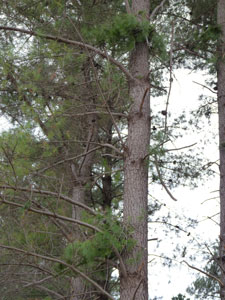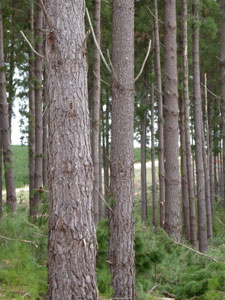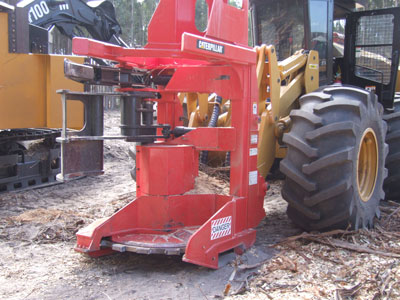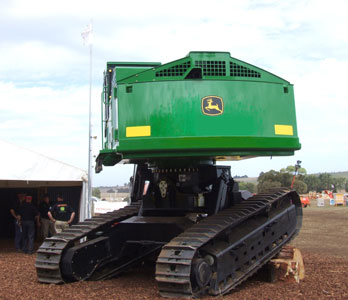
|

|
Conduct Feller Buncher Operations
Unit FPIHAR3207B:
Conduct Feller Buncher Operations
 Forest Operations > Conduct Feller Buncher Operations > Factors Affecting the use of Feller Bunchers
Forest Operations > Conduct Feller Buncher Operations > Factors Affecting the use of Feller Bunchers
Factors Affecting the use of Feller Bunchers
Trees
The size of the trees and terrain they are grown on will determine if it is possible or profitable for the feller buncher to operate. This also usually determines what type of feller buncher is best for the task.
If the sizes of trees are too large the machine will struggle, possibly compromising the safety of the machine and/or operator.
As the tree size increases, so does the height, form and crown weight which can predict the lean of the tree.
It may also affect productivity, tree placement, the ability of the machine to handle the tree during the felling and positioning process and safety of the operator.
These factors will affect the ability to control the tree’s fall. Tree and branch size form and lean; all have an effect on feller buncher operations.
 |
 |
| Figs. 1a heavily limbed trees | 1b Clean trees |
Terrain and ground conditions
The terrain on which the feller buncher is working affects the performance and safety of it.
Terrain features that have the most effect are:
- Ground slope and roughness;
- Slope length;
- Soil type and conditions.
As the slope increases the ability to climb becomes more difficult, and machine stability decreases.
Feller bunchers operate best when working up the slope as it keeps the weight over the tracks or wheels. As the slope increases, the machine becomes less stable.
You will need to know the manufacturer-specification for the degree of slope limits the feller buncher can safely handle.
For example, a manufacturer may specify self levelling cabs allow the machine to work on slopes ranging from about 22º to 28º, depending on the make and model of it.
However this may over estimate the slope that the machine can work safely and productively on.
Things such as adverse weather (rain, snow, or wind) and or light conditions, tree size, and operator skill may significantly reduce the slope limit for a particular machine.
When working downhill safe slope limits are always less than when working uphill (e.g., 12° downhill versus 21° uphill).
Machine capability
The machine capability will affect what trees it can fell and how it handles trees, characteristics and terrain.
For most feller bunchers, the overall machine capability is a combination of the base and the felling head abilities.
The following factors are important when assessing the capabilities of a machine base:
- Slew power;
- Lifting power;
- Ground clearance;
- Boom type and configuration;
- Hydraulic system performance;
- None levelling & self levelling cabin;
- Base type (tracks, wheeled machines);
- Wheeled machines with & without track;
- Tail swing, particularly if used in thinning;
- Grad ability affected by:
- machine weight;
- weight distribution;
- track motor power;
- track width / profile.
Every make of tracked or wheeled feller buncher has its own unique features that make it impossible to give accurate slope limits for each machine.
Tracked feller bunchers, with a self-levelling base, are designed to operate more efficiently when travelling on slopes cutting and handling trees.
With the slewing main body (near) horizontal, power is not wasted trying to counter gravity, and the machine weight is also more evenly distributed over the tracks.
Different types and configurations of feller bunchers used in forest operations to day are shown below.

Fig 2 Wheeled feller buncher equipped with a disc saw or commonly known as a hot saw.
The wheeled feller buncher is a fast machine however; it is mainly used on flat terrain as it is not suited to slopes or steep hills.
It can be used on a clear fell operation or first and second thinning operations.

Fig 3 John Deere tracked feller buncher equipped with self levelling cab.
The self levelling cab on the tracked feller buncher allows the machine to work in very steep terrain.
By the cabin being level, the operator is seated in a more natural working position which allows better control of the machine and higher production levels

Fig 4 Track feller buncher equipped with self levelling cabin and short
counter weight for confined forest operations.
The feller buncher in the picture above is designed with a short counter weight, and is an ideal machine for working in confined thinning operations.
You can work confidently knowing you are not damaging standing trees that you can’t see behind you as you slew the machine.
The type and amount of debris e.g. (broken off branches and blown over trees) affects the climbing ability of tracked (or wheeled) machines; as does stump size and density.
The addition of large grouser bars to the tracks pleats can increase climbing ability.
However, too much grip and the machine can climb dangerously steep slopes. Too little grip may result in uncontrolled slipping; particularly on wet ground.
Operator skill and Teamwork
The operator is the key component in any machine operation.
The capability of a machine is defined by its size and power out-put for a particular machine.
However it is the skill, motivation and care shown by the operator will give the ultimate outcome (i.e., trees felled in a timely safe manner that does not adversely affect the machine or the environment).
The overall performance of an operation is not based on individual effort and performance, rather it is how the different operators and machines integrate and work as a team that define the overall outcome.

